Visiting Ashtavinayak Temples is a popular pilgrimage tour near Pune. This is a spiritual journey of visiting 8 different Hindu temples, having 8 different forms of God Ganesha. These temples are located at 8 different places all around Pune city in the state of Maharashtra, India. The idols in these temples are said to be Swayambhu. This means nobody installed these Ganesha idols. They were found to be formed naturally. And later temple structures were built around the idols.
Trip Highlights: The savage monkeys at Lenyadri caves snatched the coconut which is the Prasad or offering of the entire pilgrimage. As one monkey snatched it out of my hands, I could see 8-10 more monkeys coming down towards me from the hill above. I still managed to snatch it back from the hands of the monkey near me. Thankfully the local guys carrying palanquins arrived at that moment and drove away all the monkeys.
Check out our Ebook on – 108 Shiva Temples in Pune
Ashtavinayak Ganpati Names List and details of the tour
The Ashtavinayak Ganpati names list in the correct sequence is as follows:
- Mayureshwar Temple, Morgaon – मयुरेश्वर मंदिर, मोरगाव
- Siddhivinayak Temple, Siddhatek – सिद्धिविनायक मंदिर, सिद्धतेक
- Ballaleshwar Temple, Pali – बल्लाळेश्वर मंदिर, पाली
- Varadvinayak temple, Mahad – वरदविनायक मंदिर, महाड
- Chintamani Temple, Theur – चिंतामणी मंदिर, थेऊर
- Girijatmaj Temple, Lenyadri – गिरीजत्माज मंदिर, लेन्याद्री
- Vighneshwar Temple, Ozar – विघ्नेश्वर मंदिर, ओझर
- Mahaganpati Temple, Ranjangaon – महागणपती मंदिर, रांजणगाव
Among these 8 Ganesha temples – 5 are in Pune district, 2 are in Raigad district but closer to Pune and 1 is in Ahmednagar district which is also closer to Pune. Pune city is the best place to start your Ashtavinayak tour.
- The number of days required: I completed the Ashtavinayak tour in 2 days. Most of the tour operators complete it in 2 days over the weekend. That makes 4 Ganesha temples per day. You can also do this pilgrimage slowly over 4 days, with 2 Ganesha temples per day. Some even do it over a period of 8 days, with 1 temple per day. There is old folklore that if you can complete all the temples in 1 day ie. 24 hours, your wish will definitely come true.
- Best time to visit: The best time to visit is any off-season. There are massive queues for entry and darshan almost all around the year. So, in order to avoid the crowds, I visited in the Diwali of 2019. And I found no queues at almost all the temples.
- Distances covered: If you start from Pune and complete this tour in the exact sequence mentioned below, it is a journey of around 840 km.
- Transport: There are various tour operators providing pre-planned itinerary and the pick and drop facility. But I would suggest you go with your bike/car for flexibility and a better experience. You can stop for snacks at small huts among the mountain ghats, and also include one or two more places in the trip.
- Where to stay in Ashtavinayak: Depending on your itinerary, you can plan to stay at any of the Ashtavinayak temples. There are various upscale hotels, as well as homestays, near every temple.
If you don’t know about God Ganesha or Ganapati, you can first read the information at the end of this blog post. Even if you know about him, you should still find it interesting to read. I have also mentioned information about the Ganesh festival celebrated in India at the very end.
I have included the images of the ‘Kalas’ or ‘Dome’ or ‘Steeple’ of the temple. In Hindu faith, even if you see the top of the temple called ‘Kalas’ in Marathi or the Steeple of the temple, it is equivalent to visiting and paying respects to God. So, if you see my pictures below, it is like you have virtually visited all the temples.
The correct sequence to visit Ashtavinayak temples
There is a predetermined sequence to visit the 8 Ashtavinayak temples. The form of Ganesha at every temple has a different name and a different story or folklore behind it. Below I have listed Ashtavinayak Ganpati names and places, in the order in which they must be visited.
My experience: I went with a tour company which organises pre-planned tours from Pune city. Unfortunately, I did not check the order or sequence in which they were going to take me around Ashtavinayak temples. The tour company did take me to all the temples but in the wrong order. They just made their job simpler by taking me in an anticlockwise circle all around Pune city, instead of the real zig-zag route. So, please check before booking the Ashtavinayak tour with some tour operators. Or just go by your own vehicle. The real sequence to visit the 8 temples is given below.
Related post: The famous Manache Ganpati in Pune
Mayureshwar Temple, Morgaon, Pune
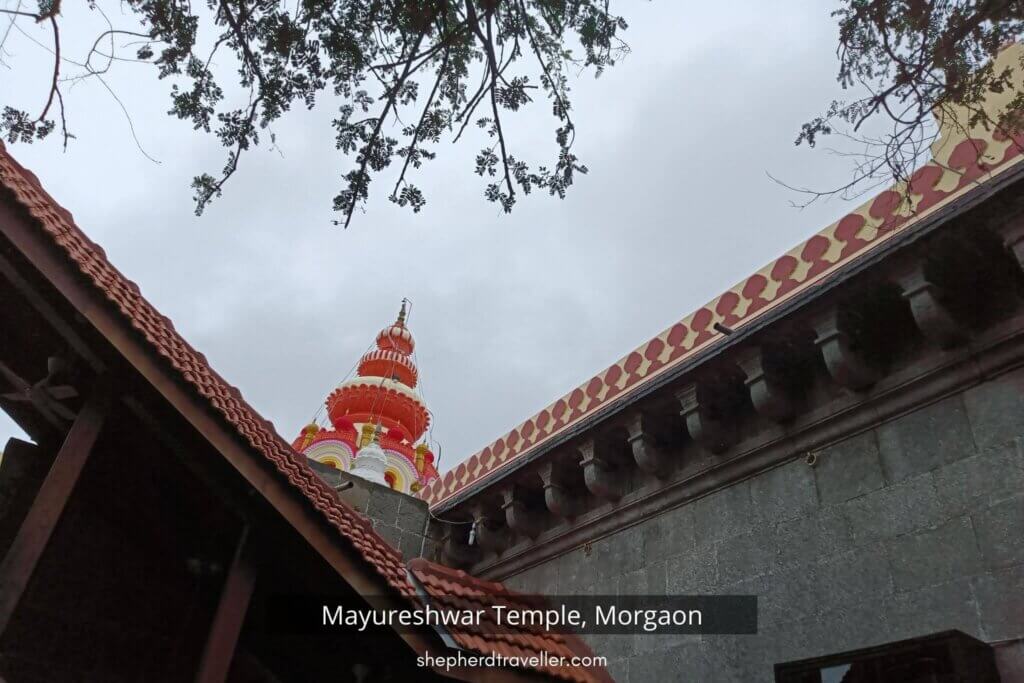
Mayureshwar temple is very close, just around 67 km away from Pune city. The name Mayureshwar is derived from the form of Ganesha sitting on a peacock. Mayur in Sanskrit translates to peacock. It is believed that Ganesha in the form of Mayureshwar killed the demon Sindhurasur at this place. The village Morgaon also gets the name from the large population of peacocks that used to live around this region. This temple has minarets around it. These were made to make it look like a mosque from a distance, to avoid constant attacks on the temple. This is the most important temple in all the Ashtavinayak temples.
There is a Nandi at the entrance of the temple. I was surprised to see the Nandi because this sacred bull is usually found outside Shiva temples. Later on, I came to know the story behind it. According to the local legend, the huge Nandi sculpture was being transported on a bullock cart to a nearby Shiva temple. The wooden cart broke down, and the Nandi landed on the ground. Since then nobody has been able to move it from this place.
There is another popular temple nearby called Jejuri temple, which you can also visit.
Siddhivinayak Temple, Siddhatek, Ahmednagar
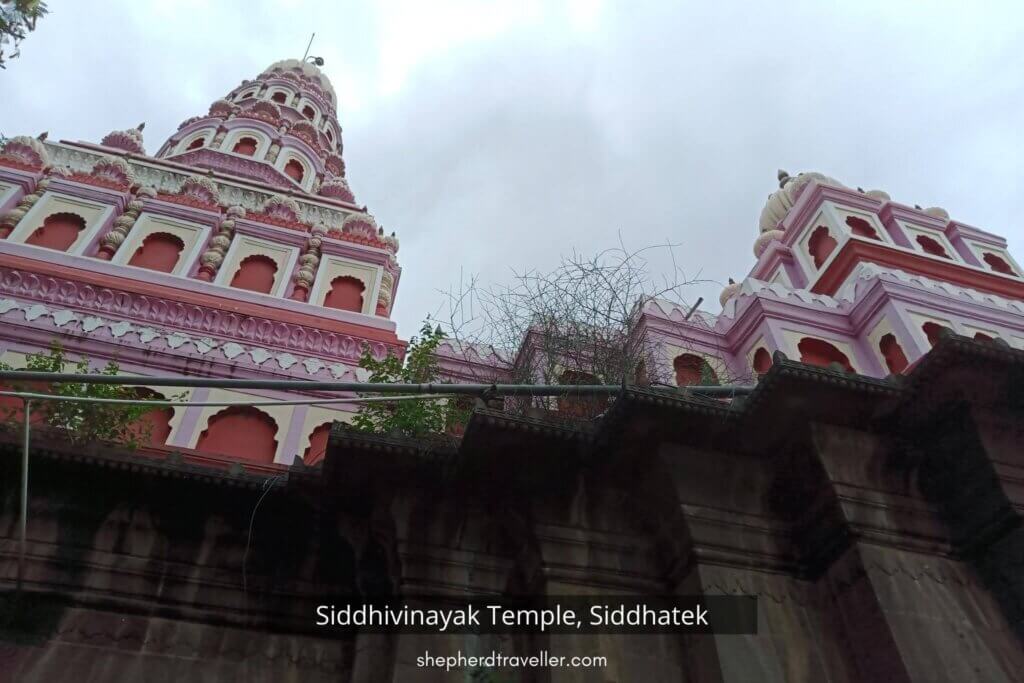
The scenery and nature around the temple are very beautiful. First, you have to cross the beautiful river Bhima on your way to this temple. The temple is located on a small hill near the river. To do one pradakshina or circumambulation, you have to go all around the hill. There is no short cut, and it takes about 15-30 minutes for doing the same. It is said that Saint Shri Morya Gosavi attained enlightenment at this place.
The Ganesha idol here has the trunk towards his right. This form of Ganesha is believed to be very hard to please, yet very powerful. This is the only idol in all Ashtavinayak who has the trunk towards his right. This form of Ganesha is called Siddhivinayak or the one who gives enlightenment. This temple is a Jagrut Kshetra, which means a place with a very powerful deity. Make sure to pray for what you want the most at this temple.
At this temple, I saw a caterpillar for the first time in my life. It had small wings which were just coming out of the cocoon. The cocoon wasn’t broken yet. In short, the caterpillar was in the process of becoming a butterfly. My first reaction when I saw it was that it’s going to die soon, and it looks so ugly. But later when I thought about it then I realised it’s actually all set to be a beautiful butterfly. This was like a sign. A caterpillar turning into a butterfly was synonymous with my stage in life at that point in time.
After completing your visit to this Siddhivinayak temple of Siddhatek, you can have lunch at the nearby town called Daund.
Ballaleshwar Temple, Pali, Raigad
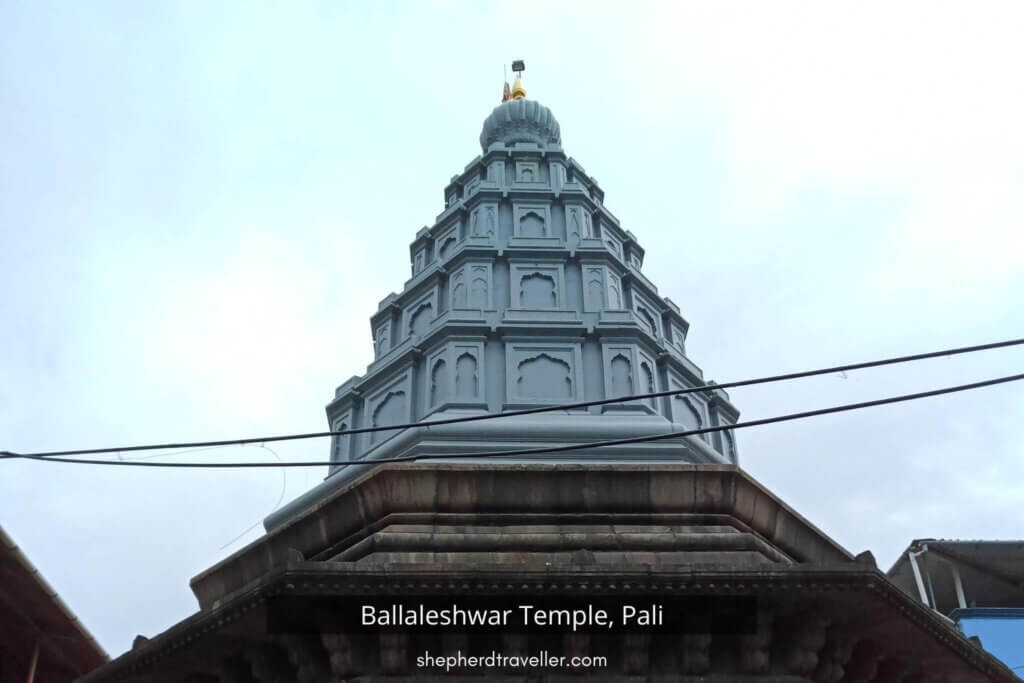
This is the only temple of Ganesha where the deity is named after his devotee. The legend goes that the small children of this village of Pali used to worship rocks. They were lead by a small boy Ballal. Once they all found a huge rock and started worshipping it as God Ganesha. When the children of the town did not return home, Ballal’s father was sent to find them all. When he reached he found that all the children were busy listening to Ganesh Purana. Seeing Ballal’s father enraged, all the children ran away. Ballal was caught as he was deeply engrossed in devotion. Ballal’s father started beating him as a punishment and later tied him to a nearby tree. Then he threw the huge rock away which split into many pieces.
He left Ballal tied to a tree, wounded and starving. Ballal continued to chant the name of Ganesha. Seeing this utmost devotion God Ganesha appeared before Ballal in the form of a Saint. He untied the ropes that tied him, healed his wounds. Ballal recognised that its Ganesha in the form of a Saint. Ganesha offered to reward a blessing to Ballal. To this Ballal said, “May I always be your devotee, and may you always stay here in this village.”
Today, there is a temple of Dhundivinayak near the Ballaleshwar temple. This is that huge rock that Ballal initially worshipped along with other children. Its believed that you should first visit the Dundivinayak temple, and then the Ballaleshwar temple. I read a signboard near the shoe stands, about visiting the Dhundivinayak temple first. There are two beautiful lakes near the temple.
Varadvinayak Temple, Mahad, Raigad
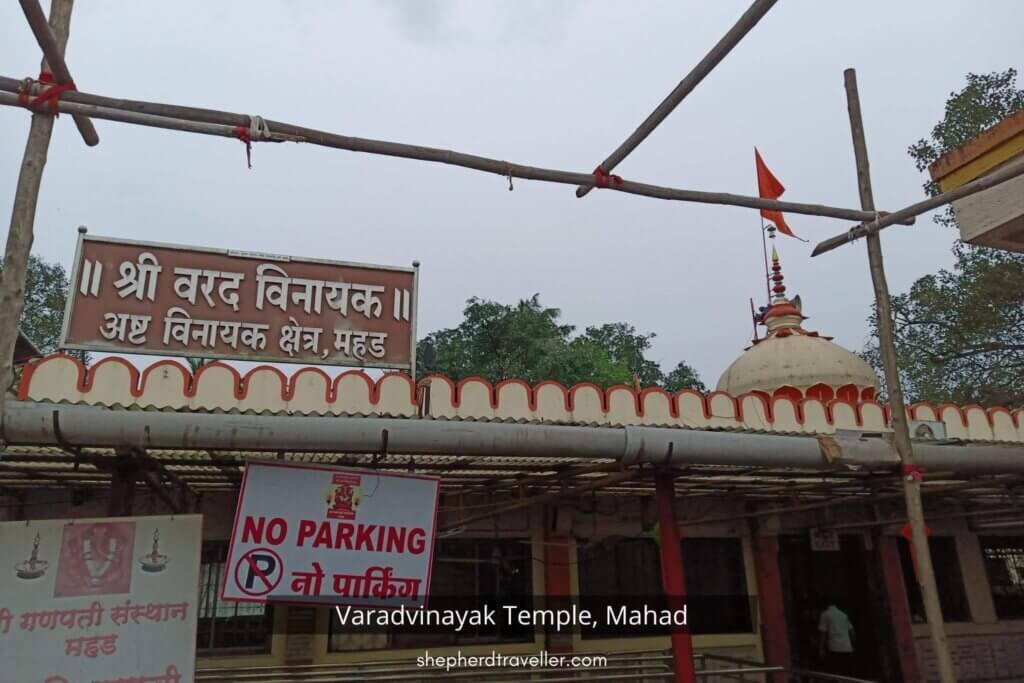
The story behind this temple goes like this. Gritsamada who is the son of Indra gets cursed by his own mother that a cruel demon will be born to him. In penance, he enters the Pushpak forest and prays to God Ganesha. Pleased by his penance Ganesha gives him a boon that his son could be defeated only by the God Shiva. Gritsamada asks Ganesha to stay in this forest forever so that devotees can come here to pray and be successful. They call this the Bhadraka forest now.
The idol of Ganesha was found in the lake, which is located right next to the temple. There is an oil lamp inside this temple which is alight continuously from 1892. There’s another reason why this temple is popular among couples. It is a common belief that eating the coconut prasad (offering) from this temple on a Maghi Chaturthi, will bless couples with a son.
Chintamani Temple, Theur, Pune
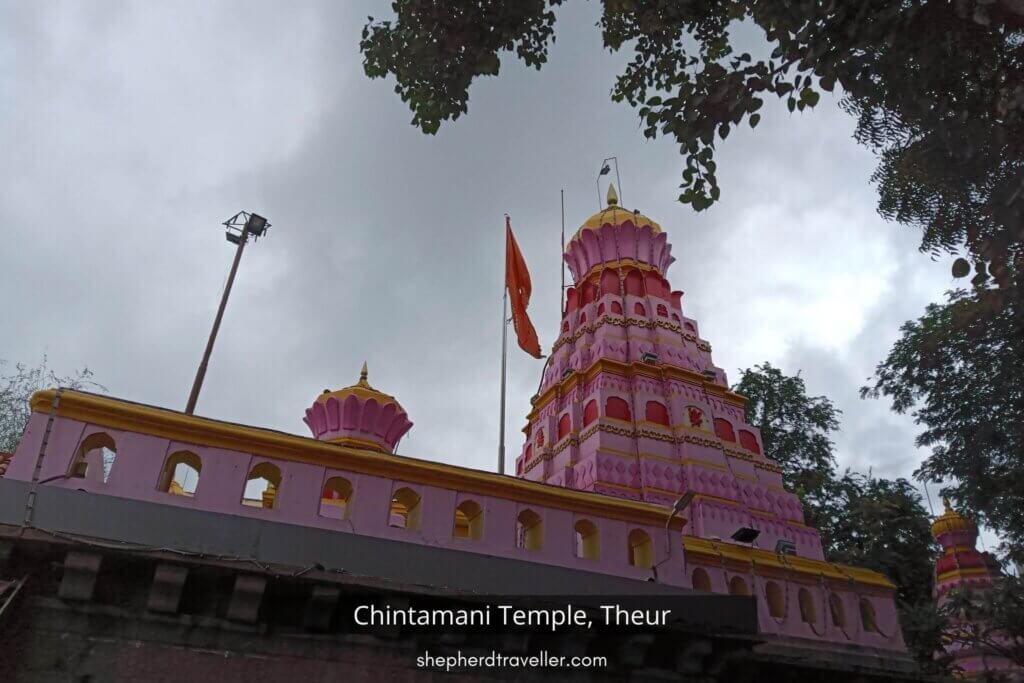
This is a beautiful temple in a small village. I loved the ambience and vibe of this temple the most. The temple’s gate is small, but once inside you will realise this is the largest one among all the Ashtavinayak temples. There are many legends of how this temple came into existence. One of them is about a fight for a jewel. A saint and a demon fight for the jewel – Chintamani. Ganesha saves the saint and slays the demon. Later the saint thanks Ganesha and refuses to take the jewel back. Instead, he pleads to Ganesha to stay here forever.
According to another legend Brahma, the God of all creations comes here to meditate. God Ganesha calmed his restless mind here at this place. They named this village Theur, which means stable. Needless to say, you should try sitting here and meditating. As I mentioned earlier the vibe of this temple is amazing. I immediately felt calm when I entered it.
Saint Shri Morya Gosavi, often visited this temple for enlightenment. Moreover, this temple was often visited by the Maratha Peshwas that lived in Pune. Inside the temple is a large bell that was offered by the Peshwas to the Chintamani temple. This European bell was acquired from the Portuguese after capturing the Vasai fort in the Konkan region.
Girijatmaj Temple, Lenyadri, Pune
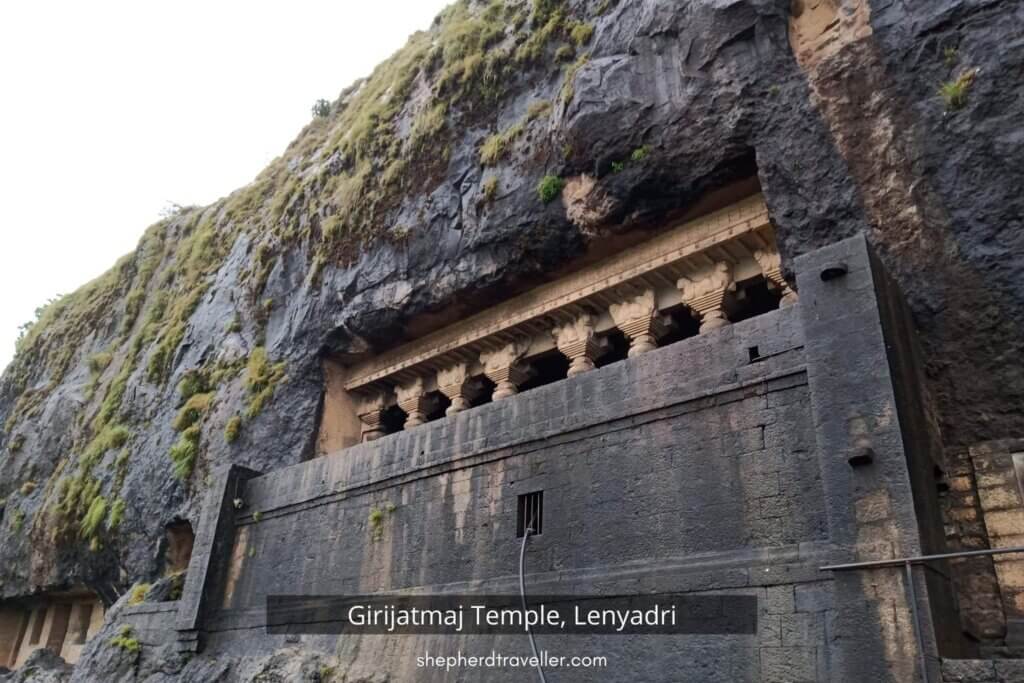
This is my most favourite temple of all the Ashtavinayak temples. Girijatmaj temple is located on top of a mountain. Girijatmaj translates to Mountain born. To reach the top, you have to climb some steep steps. It is a part of some rock-cut Buddhist caves of Lenyadri. Lenyadri caves are a group of 28 caves that are related to other caves near Pune like Karla, Bhaja, Bedse, etc. Girijatmaj temple is inside Cave no 7, which is said to be from the 1st century AD. The sculptures and architecture in the surrounding caves especially Cave No 6 and Cave No 14 are beautiful. But it is a bit difficult to reach inside these caves.
When I visited this temple, it was October, but for some reason, it was still raining in Maharashtra. So, there were small showers when I visited, and the surrounding area was full of greenery. The rain makes the steps very slippery. And you have to always look out for the monkeys. The monkeys here are insane thieves. They will grab your offerings or prasad and runway! And one of the monkeys even climbed up and sat on the head of one lady. It was scary yet thrilling. From the top, I could see green farmland stretching out around the temple for acres.
There is palanquins or Doli facility available for elders and disabled to reach the top. Basically they make you sit in a chair and carry you to the top.
Vighneshwar Temple, Ozar, Pune
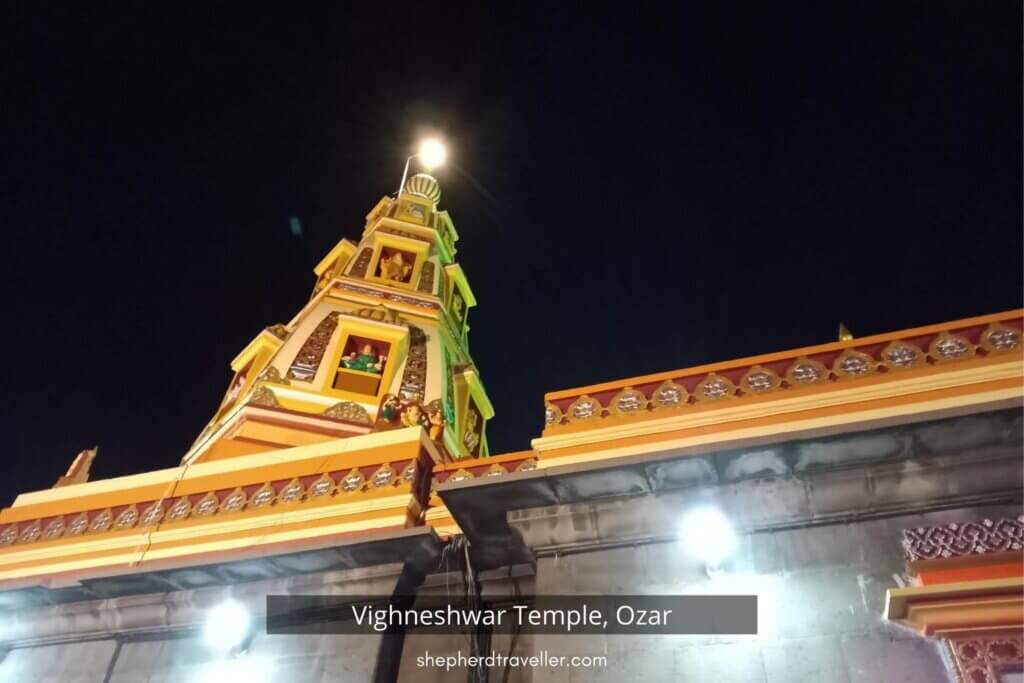
Vighneshwar means the Lord of obstacles. The legend behind this temple is that the demon Vighnasura created havoc and troubled everyone by making obstacles and disruptions in their work and sacrifice. When the people pleaded to the Gods, they sent Ganesha to fight the demon Vighnasura. After realising it was impossible to win, Vighnasura surrendered. Since then it was decided that Vighneshwara will dwell only where Ganesha is not worshipped. Thus, in the Hindu faith, Ganesha is worshipped before beginning anything.
The temple is small and in the typical Maratha architecture. They have planted several flowering trees like Jasmine along the pradakshina path or the circumambulation trail. Two large lamp towers are located near the entrance. I could not help but imagine how grand it must have looked after lighting lamps all over these towers. There is a river near the temple named Kukadi.
Mahaganpati Temple, Ranjangaon, Pune
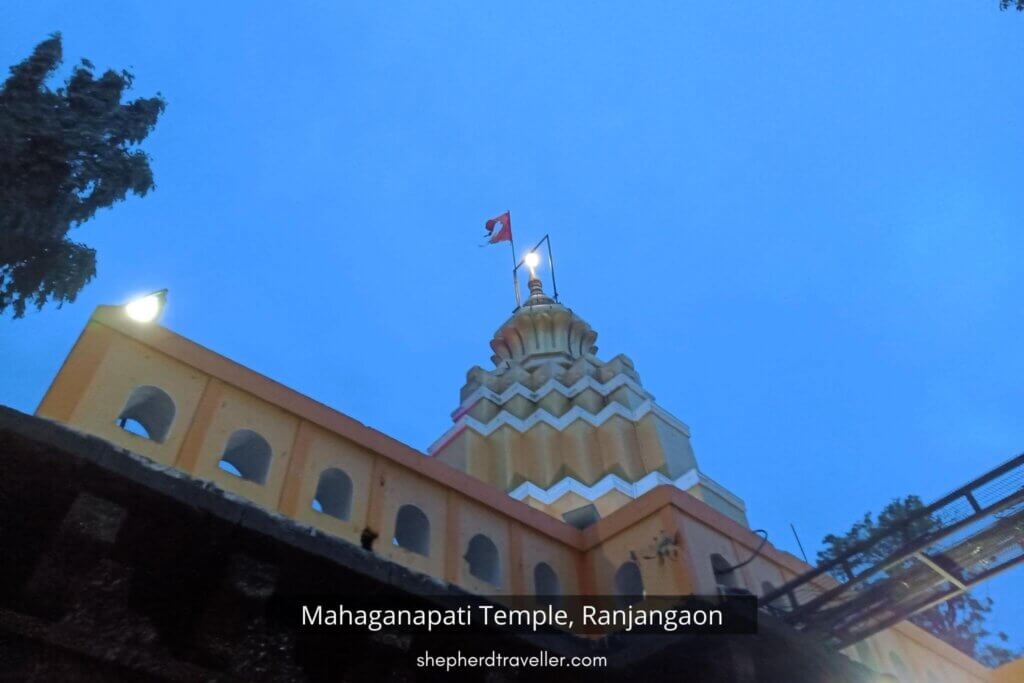
This is the eighth Ganesha in the Ashtavinayak temples. The area around the temple is very well maintained. You can see the grandeur of the massive, impressive arched gate in the picture above. This gate is a relatively new addition by the locals. There are 2 life-sized elephant statues on both sides of this new gate.
The actual temple is in the picture below. The form of Ganesha here is seated on a lotus. This temple and the deity here is considered to be the most powerful form of Ganesha. It is believed that the real idol of Ganesha is hidden in the basement of the temple. The real idol of the Ganesha is said to have 10 trunks and 20 arms. This is the largest form of Ganesha.
It is also a common belief among people that if you visit this temple, it is equivalent to doing the entire Ashtavinayak tour. The people who cannot make the entire journey of visiting all the 8 Ashtavinayak temples due to some reasons, just visit this temple.
Mayureshwar Temple, Morgaon, Pune
There is no mistake. The Ashtavinayak yatra starts and ends with the same temple of Mayureshwar located in Morgaon. Yes, the Ashtavinayak tour is said to be incomplete unless and until you go back to the Mayrueshwar temple. You should not go back to your home unless you do this. Otherwise, the pilgrimage is incomplete.
As I did my trip with a tour operator they didn’t take me back to Morgaon for revisiting the Mayureshwar temple. I am not very religious usually, but I may make vows or ask Ganesha for favours whenever I am stuck in a tight spot or in an obstacle. I don’t really know whether God exists, but somehow making the prayers gives me confidence clears my mind from any doubts.
The Prasad of Dry Coconut
It is said that you should offer a dry coconut to the Ganesha at every temple, and later eat it as a Prasad when you reach back home. Instead of taking a separate coconut every time and carrying eight coconuts home, I took and carried only one coconut. I bought a dry coconut at Mayureshwar temple in Morgaon and then carried it with me for 2 days. I used the same coconut as an offering to God Ganesha at all the 8 Ashtavinayak temples. This is the better way of doing it, rather than carrying the weight of 8 coconuts at the end. If you are a big family visiting together then you may offer a new coconut and end up with 8 coconuts.
Ganesha or Ganapati
Ganesha is an important god in Hinduism. He is said to be the god of wisdom, who tackles problems with his intelligence first. He is also called the Vighnaharta or the one who removes obstacles and disruptions. This is the reason why Hindus first remember God Ganesha before beginning any of the important tasks. And a small prayer is made to Ganesha to take care of obstacles and disruptions. The Ganesha idol sits on the dashboard near the windshield of almost all cars and vehicles in India, for the same reason.
There is another reason why Ganesha is worshipped before all new beginnings. As per Indian Vedic knowledge, any idea first enters the subconscious mind and then into the conscious mind. An idea entering the conscious mind should be obstacle-free. If the idea enters the conscious mind full of obstacles and doubts, then the same gets converted into reality – ie. in last stage Action or execution of the idea. So before starting any new idea, first Ganesha is worshipped. The mind is freed from any doubts or obstacles. And then no problems, disruptions or obstacles arise in the execution of the idea.
Why does Ganesha have an Elephant’s head?
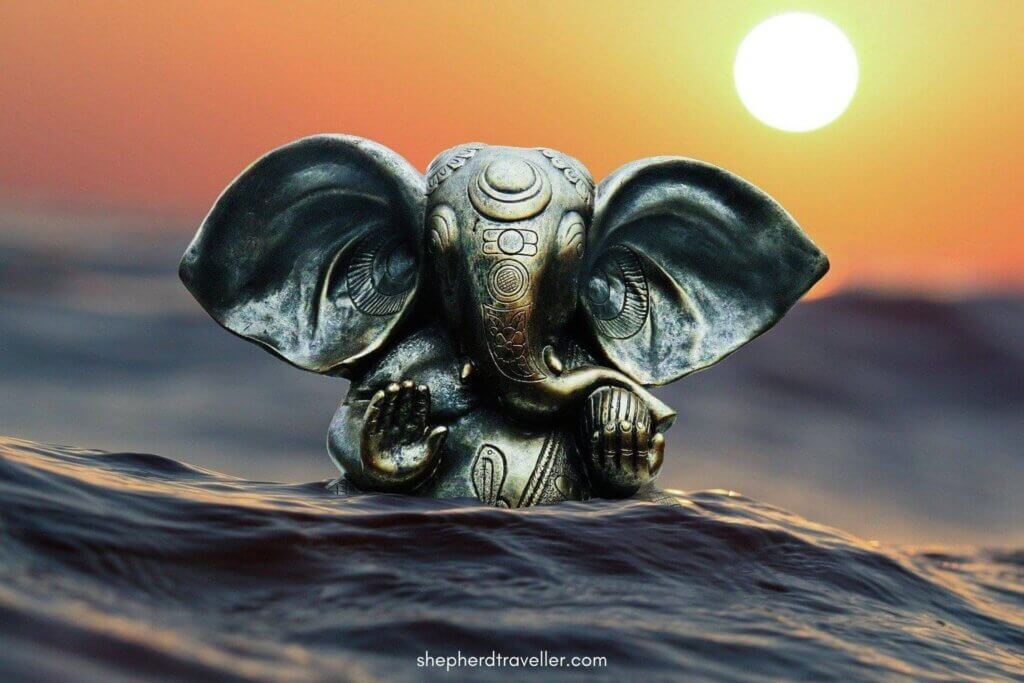
God Ganesha has an elephant’s head instead of having a human head. There are 2-3 stories that give the reason behind Ganesha’s elephant head. The most widely known and accepted one is as follows –
Goddess Parvati, the wife of God Shiva was bathing at lake Gauri Kund near Kailash Mountain. As there was nobody there to be a guard while bathing, she sculpted little Ganesha from bathing clays and Sandalwood. After she put life into her child, she asked him to stand as a guard while she bathed. Meanwhile, God Shiva arrived at Gauri Kund and asked Ganesha to step aside. Ganesha not knowing that Shiva is his father, and Parvati’s husband did not allow him to proceed. God Shiva was hence enraged and he beheaded little Ganesha. When Goddess Parvati arrived at the scene, she was enraged when she saw Ganesha killed by Shiva. She was about to destroy all the creations of the world when the God of all creations – Brahma stopped her.
The Shiva commanded Brahma to bring the head of the first animal he finds facing North. God Brahma set out and returned with the head of an elephant. God Shiva fixed the head of an elephant on his child’s body. And this is how Ganesha got an elephants head. If we see logically every part of Ganesha’s body gives us a message. The large ears of an elephant tell us to listen more, the small eyes show concentration, the tiny mouth gives the message of speaking less. The large trunk represents flexibility.
Ganesh Chaturthi or Ganesh festival
Ganesh Chaturthi is the day when little Ganesha came to earth from Mount Kailash. From this day starts a 10 day grand festival in India called the Ganesh festival. I am writing this post during this most loved festival in India. The Ganesh festival was first started in Pune city by the freedom fighter Lokmanya Tilak. It was an effort to bring the Indians together.
Now, everyone celebrating the festival brings home a small Ganesha idol each year. More idols and larger versions of Ganesha are brought in at the public pandals. This is a 10-11 day celebration which you can experience best by visiting the cities Pune or Mumbai. The dates are as per the Indian calendar, but they usually fall in August or September. In this fun-filled festival, several decorations are made or scenes are enacted by people or statues. Drum like instruments called Dhol and Tasha are played by youngsters around the city. It is almost like carnivals but even better with a spiritual twist.
FAQs about Ashtavinayak Temples
1. Mayureshwar Temple, Morgaon 2. Siddhivinayak Temple, Siddhatek 3. Ballaleshwar Temple, Pali 4. Varadvinayak temple, Mahad 5. Chintamani Temple, Theur 6. Girijatmaj Temple, Lenyadri 7. Vighneshwar Temple, Ozar 8. Mahaganpati Temple, Ranjangaon
1. मयुरेश्वर मंदिर, मोरगाव 2. सिद्धिविनायक मंदिर, सिद्धटेक 3. बल्लाळेश्वर मंदिर, पाली 4. वरदविनायक मंदिर, महाड 5. चिंतामणी मंदिर, थेऊर 6. गिरीजत्माज मंदिर, लेन्याद्री 7. विघ्नेश्वर मंदिर, ओझर 8. महागणपती मंदिर, रांजणगाव
I completed the Ashtavinayak tour in 2 days. Most of the tour operators complete it in 2 days over the weekend. That makes 4 Ganesha temples per day. You can also do this pilgrimage slowly over 4 days, with 2 Ganesha temples per day. Some even do it over a period of 8 days, with 1 temple per day. There is an old folklore that, if you can complete all the temples in 1 day ie. 24 hours, your wish will definitely come true.
If the correct sequence is followed 840 km are covered in Ashtavinayak yatra, starting and ending at Pune city
There are various tour operators providing pre-planned itinerary and the pick and drop facility. But I would suggest you go with your bike/car for flexibility and a better experience. You can stop for snacks at small huts among the mountain ghats, and also include one or two more places in the trip.
So these are all the local legends and folklore told for generations after generations in Maharashtra. If anything mentioned above was incorrect, or if you want to add up anything, Comment below!
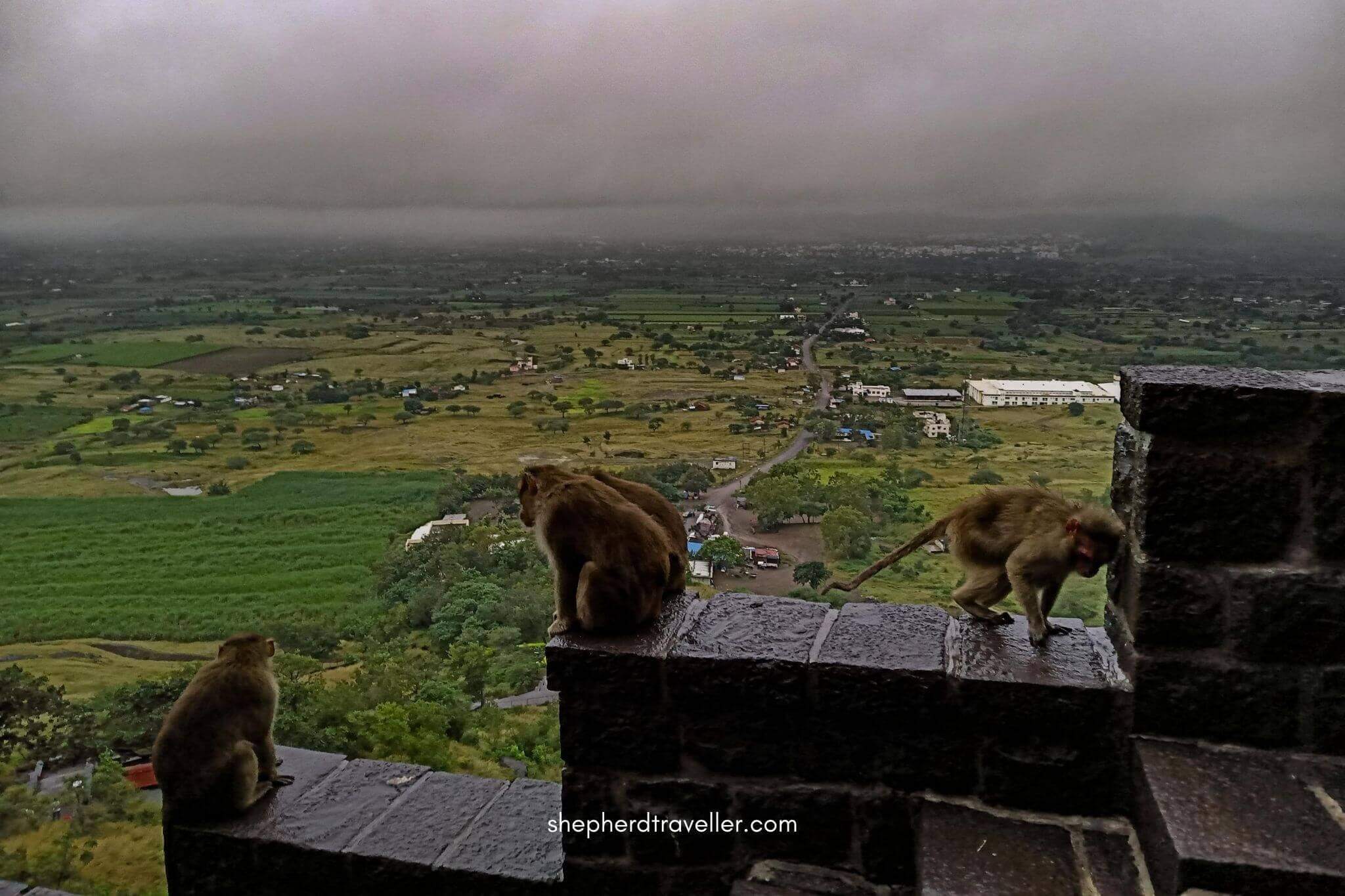
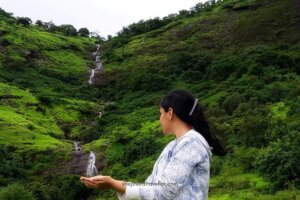
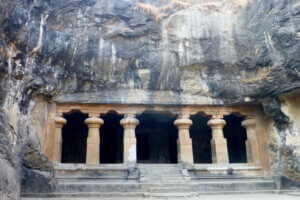
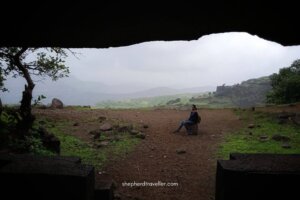
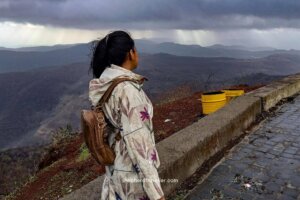
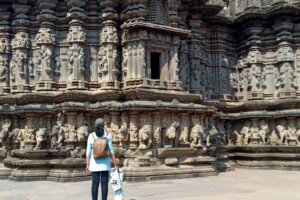
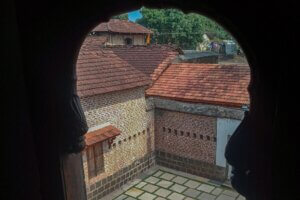
Thanks for sharing such amazing information with us it was a pleasure to read your blog and it helps all trekking bloggers I am searching for such great tips for a long time but I didn’t found such valuable info .thanks once again keep on posting in future.
I think this is an informative post and it is very useful and knowledgeable.
Dear Sir
Namaste
Thankyou for this beautiful information.In Chintamani temple i heard that there is a chintamani river.If you have any information please share it sir.
Regards
as far as I know, Mula Mutha river flows nearby this temple
Thanks a lot for sharing the information 🙏🙏
Fantastic blog. Thank for sharing this wonderful website with us. I’ll share this blog with my colleagues. I’m sure this info will be useful to those who need it.
Very Informative blog.
I am a senior citizen, planning to visit these places, engaging a car for two days.
Could you please indicate the timings of visit at all these temples, so that we can take care of the recess / lunch – break time in our itinerary. Also, if distances are indicated from each place to place in the given sequential order, may help in planning in minimizing the travel distance and time.
Thank you for sharing your experience in a detailed manner. May God Ganesha Bless you.
A gentle reminder
I checked this Blog … your topic is very interesting!